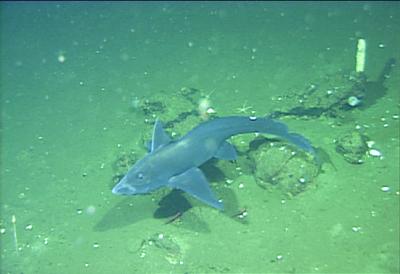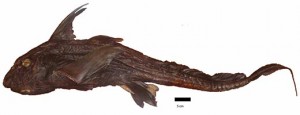
A new ghostshark species has been identified off the coast of Southern California, and
it’s darker and weirder than any shark we know.
The purplish black ancient relative of the modern shark comes packed with a suite of odd features that give its taxonomical family the name chimaera, after the mythical beast made from the parts of many animals.
“It’s a big weird looking freaky thing,” said ichthyologist Doug Long of the California Academy of Sciences. “They have some shark characteristics and they have some that are very non-shark.”
Perhaps the most intriguing feature of the newly described species, Hydrolagus melanophasma, is a presumed sexual organ that extends from its forehead called a tentaculum.
“They have this club on the top of their head with spikes. People think it’s used for mating,” Long said. “It’s like a little mace with little spikes and hooks and it fits into their forehead. It’s jointed and it comes out. We’re not sure if it is used to stimulate the female or hold the female closer.”
The species is yet another example of the tremendous, unknown biodiversity that still exists near heavily populated regions like the Los Angeles coastline. It was actually “discovered” long ago in the sense that museum specimens of the fish existed at Scripps Oceanographic Institute. But it wasn’t until a team of researchers from the Pacific Shark Research Center and the California Academy of Sciences came together to examine the odd creatures that they realized they were looking at something new.

“There’s an old expression by a well-known paleontologist that the best place to find new dinosaurs is in a museum,” said Dave Ebert, a researcher at the Pacific Shark Research Center, and a co-author of the paper. “If you go to the California Academy of Sciences and go wandering through the fish collection, you’ll find new species just sitting on shelves there.”
In fact, he’s had his students do just that in various collections. They’ve found 11 new species of sharks, rays and chimaeras in the last three years. The latest description, lead-authored by student Kelsey C. James, was published in the journal Zootaxa this month. They made the identification not just from the formalin-preserved specimens like the one pictured above, but also from video of the living creature from a Monterrey Bay Aquarium Research Institute ROV.
Ebert also said that figuring out what species are actually living in the oceans isn’t just an academic task. It’s important to understand the biodiversity that ecologists are trying to protect from being accidentally killed by fishermen, even if those creatures are not as charming as dolphins or awe-inspiring as great whites.
“Ecosystem-based management is such a buzzword right now, but then you start looking at a lot of the fishes and we don’t even know what some of these are,” Ebert said. “A lot of skates and rays and the chimaeras are not as charismatic as white sharks or whale sharks or a manta ray, but these things are probably taken in far greater numbers in terms of by-catch.”
Until recent years, chimaeras hadn’t received much study, so people treated the similar-looking creatures found in different spots across the world as the same species. It’s hard to study or account for animals like the California chimaera if you don’t even know what they are.
“We didn’t have a name for this thing until now,” Ebert said.
Its genus name, hydrolagus, means “rabbit teeth” “water rabbit” after the chimaera’s crab- and clam-munching dental work. Nine specimens of the fish have been identified from the Sea of Cortez up the California coast.
from : www.wired.com, google
No comments:
Post a Comment